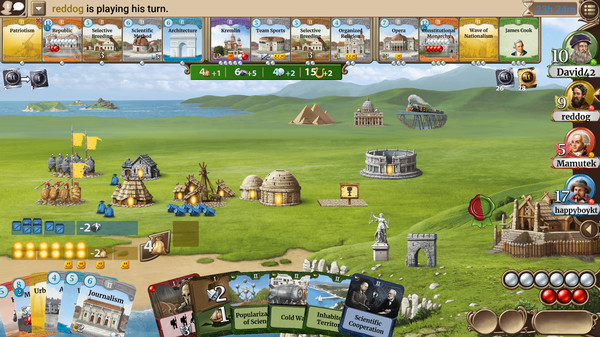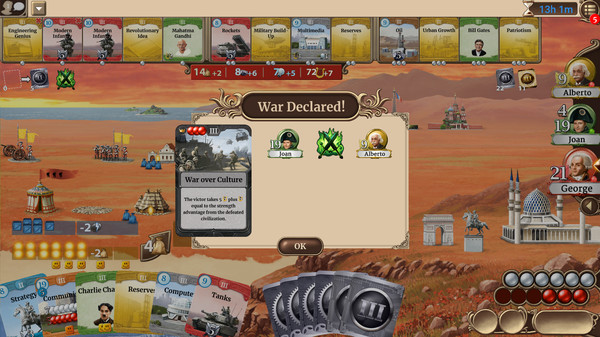Through the Ages is a digital adaption the boardgame with the same name. This a very complex boardgame with many different mechanics and strategies you can pursue for your victory. You can play this game with up to four players or exychange human players through Ai. The game is very similiar to Sid Meier's Civilzation, but in boardgame form (although you could argue that Civilization in itself is already some sort of boardgame). The goal of the game is to have the greates civilization at the end of a match and in order to achieve this you need to have the most culture points. There are various materials players have to juggle in order to build up their civilization. Food and resources are the most basic elements you need. Food is spent to generate more population and is needed to maintain population. The more population (yellow pieces) you have, the more food they need which translates into less food generation. Resources on the other hand are materials to build buildings and wonders. Both food and resources are represented through the same blue boxes in the game which is important because your yellow bank for population and blue bank for materials are limited. Whenever you run out of a square inside your bank (which is shown at the bottom of the screen) you start to have negative effects. In case for population you will now need happiness to keep your workers satisfied or else they will destroy half your materials each round. If you run out of blue boxes on the other hand you have "overproduced" which means now people will steal your mertials (which means you lose blue boxes again at the end of the round). There are multiple ways to manage this. In case of happiness you can build different so called "urban buildings" to help you out. Each players starts with the ability to build temples which generates one happiness and one culture point. Other urban buildings can be gained through cards that are openly aviable for all players to pick and build. Resources on the other hand can be made more efficient by building higher tiers of production buildings. Better farms and better mines will count as more resources for less blue boxes, effectively giving you both more resources per round whjile also minimizing the damage of overproduction. But of course the easiest way to avoid losing materials is to just use them when aviable. As the title of the game tells you, this game is played through different ages. The first one is the age of antiquity also known as "A age". All the following ages are numbered with age 1 to 4. Each age, except the fourth one, havbe their own cards which get better and more efficient in later ages. Players can pick cards fromt he top row during their turn which takes one or more action depending on how long the card was aviable to take. Even if no one takes cards, older cards will always get discarded after each turn because the prorgess of time cannot be stopped. There are different types of cards aviable. Civil cards are actions that you can use to get a one-time bonus. This can give you extra materials or allow you to construct buildings for cheaper prices. Leader cards are special cards. Each player can have only one leader which has a permanent effect as long as they have that leader. Leaders can be taken to the next age but if they are older than two ages they expire (this also counts for any other card as well). Tech cards can be used to research a new tech. This can be a new building, an upgraded building or simply a technology that has a permantent effect for your civilization. You pay for those with science that you get from labs but you can take the card even before you can pay the price for it. Wonders are powereful buildings with lasting effects that take multiple steps to build. You can only build one wonder at a time which starts when you take the card and every new wonder after the first was finished will cost you more actions for you to take the card. Wonders are one of the most common ways to generate culture points for your victory. Lastly there are giovernment cards. A goverment works like a leader but on a bigger scale. They need a lot of science to play but you can also instead skip an entire turn to get them immeditely. New governments increase the amount of actions you can have per round. There is also an entirely seperate deck of cards called the military deck. M;ilitary cards are not open to pick and instead drawn whenever you have military actions left (which are seperate from your standard actions). Military cards allow you to attack or defend against your neighbours but also have all kind of event cards that you can play at the start of your turn. Event cards are placed in a seperate deck and every time a new event is placed under it, the top card gets revealed. Some of thjese event cards are colonies, an important mechanic in the game. Colonies is extra land that players compete against. They can send military units to claim it and the one with the most military units gets the colony. Each colony has different benefits, some give extra population, some science, some materials and so on. What is important here is that colonies are the only way to increase your yellow and blue bank, which reduces the negative effetcs of overpopulation and overproduction. As I mentioned before, there are multiple strategies that polayers can try in this wonderful game. You can focus on science and produce all the technologies you need to win, try to generate a strong military and take what you need from your neighbours or just focus on pure cultuire generation thorugh relegion and wonders. Players usally want a mix of everything a little bit but they will also want to focus on one specific thing depending on their leaders and technologies. One thing I have to mention is the AI. This game was programmed by the designer of the actual boardgame and because he knows his own game so well you can expect to face a brutal Ai. There is no cheating AI here, the Ai just knows the most efficient strategies and will execute these each match. There are three difficulty settings and the slider just increases the number of mistakes the AI will make towards the perfect strategy. I have yet to beat the perfect Ai and even struggle on medium. Easy is fine for players that start out learning the game and will probably what players will use most of the time until they have a good grasp of the rules and strategies this game provides. Another thing I like to point out is the visual presentation of the game. The digital version completely removes the board and has replaced it with a beatiful background in which all the buildings are constructed as you play out their cards. It looks so much better than the board from the physical game. The UI is also clean and makes managing materials so easy. Playing the physical version is a hassle with all these different things you have to track. I think it really shows that the designer of the boardgame, who has expertise in software development, also programmed the game. He knows his game the best and has created an amazing digital adaption that fits perfectly it's style. He also made the tutorial not only easily understandable but spiced it up with humour to keep players attention. More tutorials should be done like this so players don't stop midway through because they were bored.
Expand the review



















